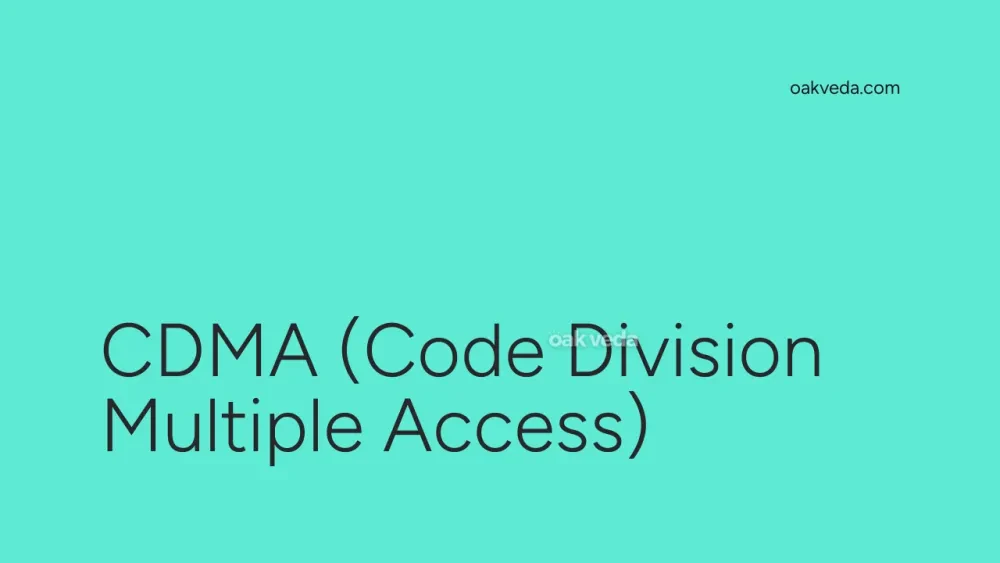
What is the Full Form of CDMA?
CDMA is the abbreviation for Code Division Multiple Access. This term represents a channel access method used in various communication technologies, particularly in wireless cellular networks.
What is Code Division Multiple Access?
Code Division Multiple Access is a spread-spectrum technology that allows multiple users to share a common frequency band simultaneously. Unlike other multiple access techniques, CDMA assigns unique codes to each user, enabling them to transmit data over the same frequency range without significant interference.
Origin and Development of Code Division Multiple Access
The concept of CDMA has a rich history dating back to the mid-20th century:
- 1935: Soviet scientist Dmitry Ageev first introduced the concept of spread-spectrum communication.
- World War II: CDMA principles were used to prevent signal jamming in military communications.
- 1957: Leonid Kupriyanovich applied CDMA concepts in designing an automated wearable mobile phone.
- 1993: The Telecommunications Industry Association (TIA) approved CDMA specifications for commercial use.
- 1995: The first commercial CDMA network was launched in Hong Kong.
- 1998: CDMA systems had attracted over 16 million users worldwide.
- 2000s: CDMA became a foundation for 3G and 4G cellular technologies.
How does Code Division Multiple Access work?
CDMA operates on the principle of spread-spectrum technology:
- Each user is assigned a unique code sequence.
- The user's data is spread across the entire available bandwidth using this code.
- The receiver uses the same code to extract the original data from the spread signal.
- Multiple users can transmit simultaneously, as their unique codes allow the receiver to distinguish between different signals.
This approach allows CDMA to efficiently utilize the available spectrum and accommodate more users compared to other multiple access techniques.
Types of Code Division Multiple Access
There are several variants of CDMA technology:
- Direct Sequence CDMA (DS-CDMA): The most common form, used in cellular networks.
- Frequency Hopping CDMA (FH-CDMA): Employs frequency hopping to spread the signal.
- Time Hopping CDMA (TH-CDMA): Uses time slots to differentiate between users.
- Wideband CDMA (W-CDMA): Used in 3G UMTS networks, offering higher data rates.
Functions of Code Division Multiple Access
CDMA serves several crucial functions in wireless communication:
- Multiple Access: Allows numerous users to share the same frequency band.
- Interference Reduction: Minimizes interference between users through unique coding.
- Capacity Enhancement: Increases the number of simultaneous users in a network.
- Security: Provides a level of privacy through signal spreading and coding.
Applications of Code Division Multiple Access
CDMA technology finds applications in various fields:
- Cellular Networks: Used in 2G, 3G, and some 4G systems.
- Global Positioning System (GPS): Enables accurate positioning and timing.
- Satellite Communications: Used in systems like OmniTRACS for vehicle tracking.
- Wireless Local Loop (WLL): Provides last-mile connectivity in some regions.
- Military Communications: Ensures secure and jam-resistant communications.
Features of Code Division Multiple Access
CDMA offers several distinctive features:
- Soft Handoff: Allows seamless transition between cell towers.
- Power Control: Adjusts transmission power to minimize interference.
- Frequency Reuse: Enables the use of the same frequency in adjacent cells.
- Variable Rate Transmission: Adapts data rates based on user needs.
- Multipath Resistance: Mitigates the effects of signal reflections.
Benefits of Code Division Multiple Access
CDMA technology provides numerous advantages:
- Increased Capacity: Supports more users compared to TDMA or FDMA.
- Improved Call Quality: Reduces dropped calls and noise.
- Enhanced Privacy: Makes eavesdropping more challenging.
- Efficient Spectrum Usage: Maximizes the use of available bandwidth.
- Longer Battery Life: Power control feature extends mobile device battery life.
Limitations or Challenges of Code Division Multiple Access
Despite its benefits, CDMA faces some challenges:
- Complex Implementation: Requires sophisticated signal processing.
- Near-Far Problem: Signals from nearby users can overpower distant ones.
- Synchronization Issues: Precise timing is crucial for optimal performance.
- Limited Global Adoption: GSM became more widespread in many regions.
Future Developments in Code Division Multiple Access Technology
While pure CDMA is less common in newer cellular standards, its principles continue to influence modern communication technologies:
- 5G Networks: CDMA concepts are incorporated in 5G's multiple access schemes.
- IoT Communications: CDMA variants are being explored for low-power, wide-area networks.
- Cognitive Radio: CDMA principles may enhance spectrum sharing in future systems.
- Quantum Communications: CDMA concepts could be applied to quantum key distribution.
FAQs on CDMA Full Form
-
What is the primary difference between CDMA and GSM? CDMA uses spread-spectrum technology and unique codes, while GSM uses time division and frequency division multiple access.
-
Is CDMA still used in modern cellular networks? While pure CDMA is less common, its principles are incorporated in 3G, 4G, and 5G technologies.
-
Why was CDMA popular in some countries but not others? Factors like licensing, infrastructure costs, and existing technology investments influenced CDMA adoption.
-
Can a CDMA phone work on a GSM network? Generally, no. CDMA and GSM use different technologies, making them incompatible without dual-mode capabilities.
-
What replaced CDMA in cellular networks? LTE (4G) and 5G technologies have largely replaced pure CDMA systems in modern cellular networks.
In conclusion, Code Division Multiple Access, the full form of CDMA, has played a significant role in shaping wireless communication technologies. While its pure form is less prevalent in modern cellular networks, the principles behind CDMA continue to influence and enhance current and future communication systems.
You may be interested in:

